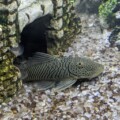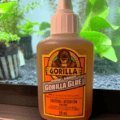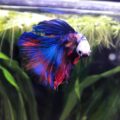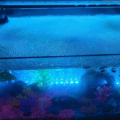One of the biggest reasons why I love this hobby is the sheer beauty that an aquarium can add to any living space.

It’s no coincidence that some of the most lavish restaurants in the world have a beautiful aquarium with super colorful fish.
Who wouldn’t like to dine next to an amazing backdrop of the ocean?
However, creating your very own piece of aquatic paradise isn’t always that easy.
So, to spare you the trouble, I’ve made a list of the 16 prettiest aquarium fish.
16 of the World’s Prettiest Aquarium Fish
Even though I’ve tried to be unbiased when ranking each fish, beauty will always be subjective.
Some people may find the symmetrical color patterns of Bettas to be pretty, while others will prefer the haphazard color schemes of Discus fish.
Therefore, some of the entries in this list might surprise you. For my selection, I looked at both freshwater and marine fish and ranked them based on their body shape, color pattern and uniqueness.
Without any further ado, here are the top 16 most beautiful aquarium fish:
16. Longhorn Cowfish – Lactoria cornuta

by Sk4peep
| Minimum Tank Size: | 100 gallons |
| Maximum Body Size: | 20 inches (50.8 cm) |
| Setup: | Saltwater |
| Suitable for Beginners: | No |
The Longhorn Cowfish from the Lactoria genus may not win any beauty pageants, but its cuteness is undeniable!
How can anyone resist the charm of its uniquely shaped body and peculiar horns?
However, their charm comes at a deadly price.
The horns of Longhorn Cowfish serve an evolutionary purpose, which makes them harder to eat by predators.
As an added defense mechanism, their body also contains a lethal toxin.
The toxin is released when a cowfish feels threatened and can wipe out your entire aquarium if you’re not careful.
To avoid such unpleasantries, make sure you have done your due diligence before adding any cowfish to your tank.
It’s also a good rule of thumb to introduce it as the first fish in your tank, to reduce unwanted risks.
Author’s note: Many people confuse the Longhorn Cowfish with Ostracion cubicus, or Yellow boxfish. While they do share the same family, these two fish belong to different genera.
15. Glofish species

by rainbowsprinkles
| Minimum Tank Size: | varies depending on the species of Glofish but generally a 20-gallon tank should be fine for most |
| Maximum Body Size: | varies depending on the species |
| Setup: | Freshwater |
| Suitable for Beginners: | Yes, these are common beginner fish |
Glofish are species of fish that have been genetically modified to glow in the dark and under a UV light. The species that currently sell under the label of “Glofish” are the following:
- Zebra Danio
- Black Skirt Tetra
- Tiger Barb
- Bronze Corydoras
- Pristella Tetra
- Betta
- Rainbow Shark
All of these species are beautiful on their own and adding a brightly glowing color to them makes them even more so. I’ve even listed the Betta fish further down in this article.
Anyhow, Glofish are intensely colorful and come in a variety of different whole-body colors. Currently, each glofish species comes in six different colors:
- Starfire Red
- Electric Green
- Sunburst Orange
- Cosmic Blue
- Galactic Purple
- Moonrise Pink
This diversity makes Glofish exceptionally pretty and, generally, a very attractive option for beginners in the hobby. Looking after Glofish is not difficult, as long as you play your cards right with the fish community.
I have a separate article that dives deeper on that topic, covering species-based tank size recommendations and fish numbers. You can read that article by visiting this link.
On that note, I have another article on appropriate tank mates for Glofish to make your fish community even more exciting. You visit that article by clicking here and do check the extensive chart I created that will help with picking Glofish tank mates!
14. Albino Oscar Fish – Astronotus ocellatus
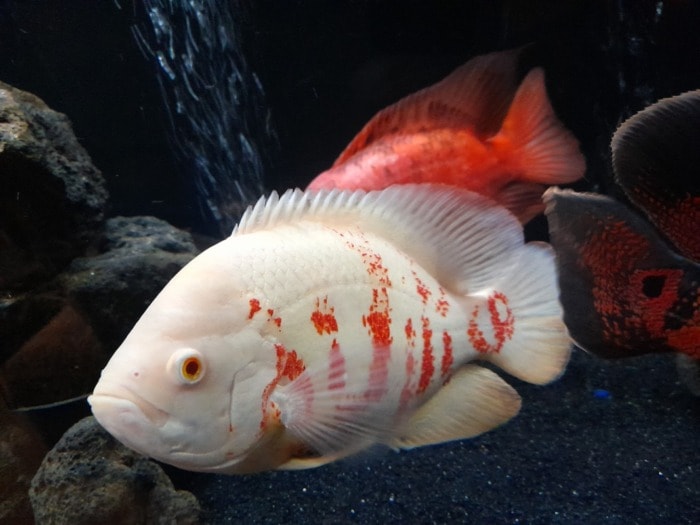
by PaulVerrall
| Minimum Tank Size: | 55 gallons or larger |
| Maximum Body Size: | 11-12 inches (28 to 30.5 cm), but some specimens could grow up to 16 inches (40.6 cm) in ideal conditions |
| Setup: | Freshwater |
| Suitable for Beginners: | No |
There are several Oscar breeds – members of the Astronotus genus – but the coolest one in my eyes is the Albino Oscar. Unlike other albino species, the Albino Oscars have opaque milky white scales, which make their red checkerboarding pop.
Their pattern may be near the tail or cover the whole body.
The pattern is strictly individual, with some fish having a more scattered scale pigmentation than others.
With beauty being skin deep, it’s worth noting that these pet fish are quite intelligent and have an amicable personality.
Well deserving of the moniker “Water Dogs”, Oscars usually wag their tail when they are about to receive a snack.
Author’s note: Same as pleco species, Oscar fish have a rapid growth rate during their first year. Under the right conditions, a specimen could increase its size by 1 inch per month.
13. Humuhumu Triggerfish – Rhinecanthus rectangulus

by andromeda
| Minimum Tank Size: | 100 gallons or larger |
| Maximum Body Size: | 10-12 inches (25.4 to 30.5 cm) |
| Setup: | Saltwater |
| Suitable for Beginners: | No |
Coming from the Rhinecanthus genus, the Humuhumu Triggerfish or Humuhumunukunukuapua’a (what a mouthful) is the official fish of the state of Hawaii, and it’s easy to see why.
Its gorgeous visual appearance is instantly recognizable anywhere you see it.
The coloration of the Humuhumu Triggerfish is characterized by a dark stripe separating the lower and upper body.
The upper body has an orange shade, with two angular, neon green lines outlining a purple wedge at the base of its tail.
The lower part of its body, on the other hand, is white and runs from the dorsal fin all the way to the mouth.
With regards to its beauty, however, the Humuhumu can be a bit odd at times.
It may, for instance, try to communicate through grunting, which isn’t the most appealing of sights.
12. Crowntail Betta – Betta splendens
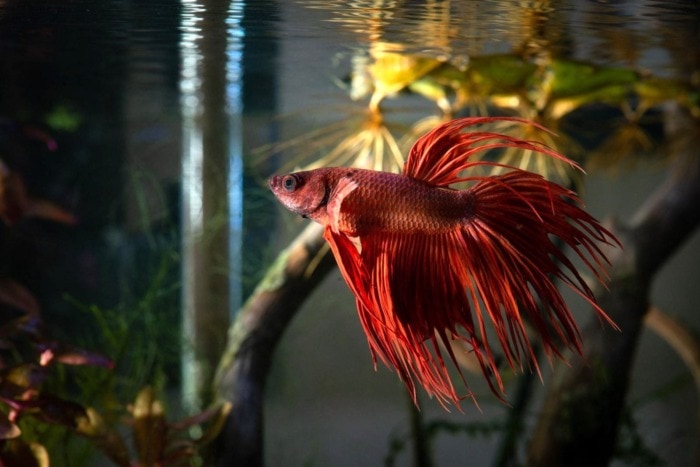
by siraf72
| Minimum Tank Size: | 10 gallons, however, could also be kept in a smaller 3-4 gallons one if you’re not a beginner |
| Maximum Body Size: | 2.7 inches but 3 inches are possible (between 6.8 and 7.6 cm) |
| Setup: | Freshwater |
| Suitable for Beginners: | Yes |
No list like this one would be complete without the addition of the well-known Betta genus. They are, in fact, one of the best freshwater pet fish for beginners.
Siamese fighting fish are among the most popular fish in the hobby for a reason. Their uniquely shaped tales combined with the multitude of color schemes they come in, can easily make them the centerpiece of any aquarium.
For the purpose of this list, I’ve narrowed down my choice to a single Betta breed – the Crowntail.
Crowntails have arguably the most distinct-looking tails of all betta types.
The significantly reduced webbing between the rays of their caudal fin, makes their tail look like an inverted crown.
This exudes an almost regal elegance that’s yet to be matched by another freshwater species.
For saltwater fish that can live in a 5-gallon aquarium check this article out.
11. Pajama Cardinalfish – Sphaeramia nematoptera

by Charles
| Minimum Tank Size: | 30 gallons |
| Maximum Body Size: | 3 inches (7.6 cm) |
| Setup: | Saltwater |
| Suitable for Beginners: | Yes |
This adorable little fellow is a great addition to any saltwater aquarium and is suited for beginners as well.
What makes the Pajama Cardinalfish from the Sphaeramia genus truly pretty, however, is the stark contrast between the posterior and anterior sides of his body.
The posterior side has a white base covered in orange specks, while the fins and the tail are translucent.
The rest of the body is separated by an iridescent blue stripe that overflows to yellow at the head.
Due to their peaceful nature, these small fish are a great fit for planted marine aquariums. They love to hide in sea grass and other plants. They should be kept in small schools and require at least 30 gallons of water.
10. Clownfish – Ocellaris
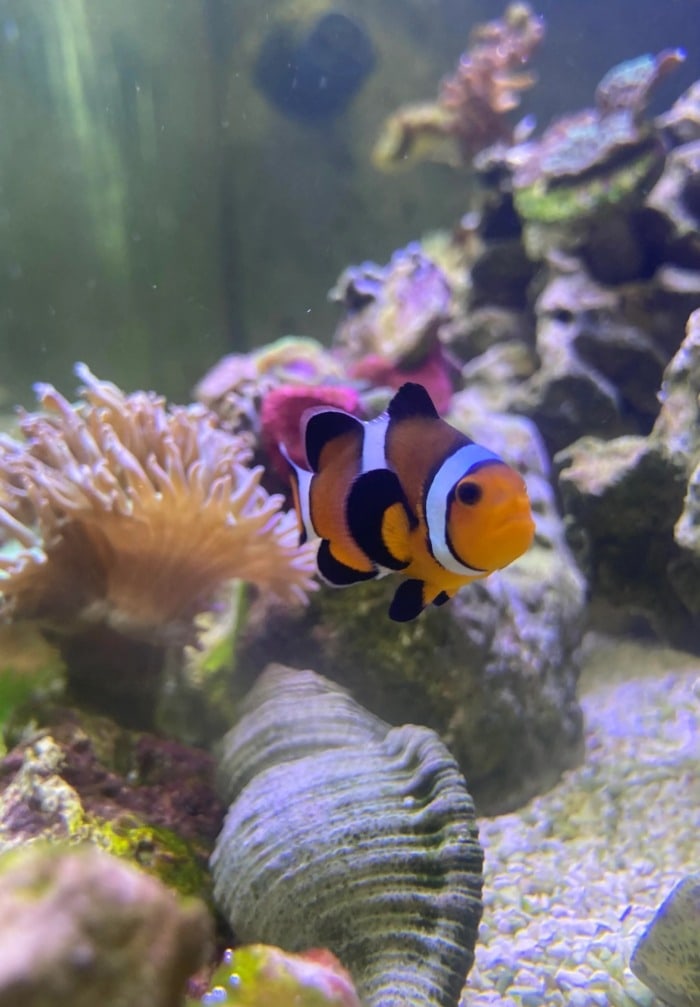
by Hungry_Jellyfish3638
| Minimum Tank Size: | 20 gallons |
| Maximum Body Size: | 3.5 inches (9 cm) |
| Setup: | Saltwater |
| Suitable for Beginners: | Yes |
The cartoonish look of clownfish from the Amphiprion genus has always struck me as perplexing. Their vivid orange-white patterning, makes them seem like they were drawn by a sketch artist.
Even when I’m observing one, there’s still a part in my brain that’s not quite sure if they’re real or not.
It’s truly uncanny!
Nonetheless, this doesn’t take away from their beauty.
Quite the contrary, it just makes them more attractive.
Putting looks aside, clownfish have a quite interesting symbiotic relationship with anemones.
Using their bright colors, they lure predators into the anemone, who subsequently get poisoned and killed by it.
As a reward, the clownfish receives nourishment in the form of food scraps.
Author’s note: Male clownfish are actually the primary caregivers for their offspring. Before the eggs are hatched, they spend most of their time assuring the eggs are kept clean.
9. Yellow Boxfish – Ostracion cubicus

by WallyB
| Minimum Tank Size: | 125 gallons |
| Maximum Body Size: | 17.7 inches (45 cm) |
| Setup: | Saltwater |
| Suitable for Beginners: | No |
These fish, within the Ostracion genus, have a cubic-shaped yellow body, covered in black polka dots.
As they mature, their yellow coat starts to shift towards greenish, while the size of the spots decreases.
The visual appearance of male specimens slightly differs from that of female ones.
Males usually have somewhat of a purple coloring with paler dots, whereas the color of females leans more on the green side of the color spectrum.
Just like the Longhorn Cowfish, a Yellow Boxfish might release a deadly toxin in the water if it’s stressed. Unfortunately, this could also happen when it dies.
However, there are some tell-tell signs you can look out for if you’re concerned about the health of your boxfish. When a yellow boxfish is about to die, it becomes sluggish and starts to rapidly lose its colors.
If you also notice white foam on the top of the water column, it most probably means the toxin is already present in the water. In case this happens, it’s important to remove the other fish from your aquarium and clean it thoroughly.
Author’s note: Yellow boxfish seem to hover in the water when they swim, due to a unique form of swimming called ostraciiform swimming.
8. Rot Turkish Discus – Symphysodon
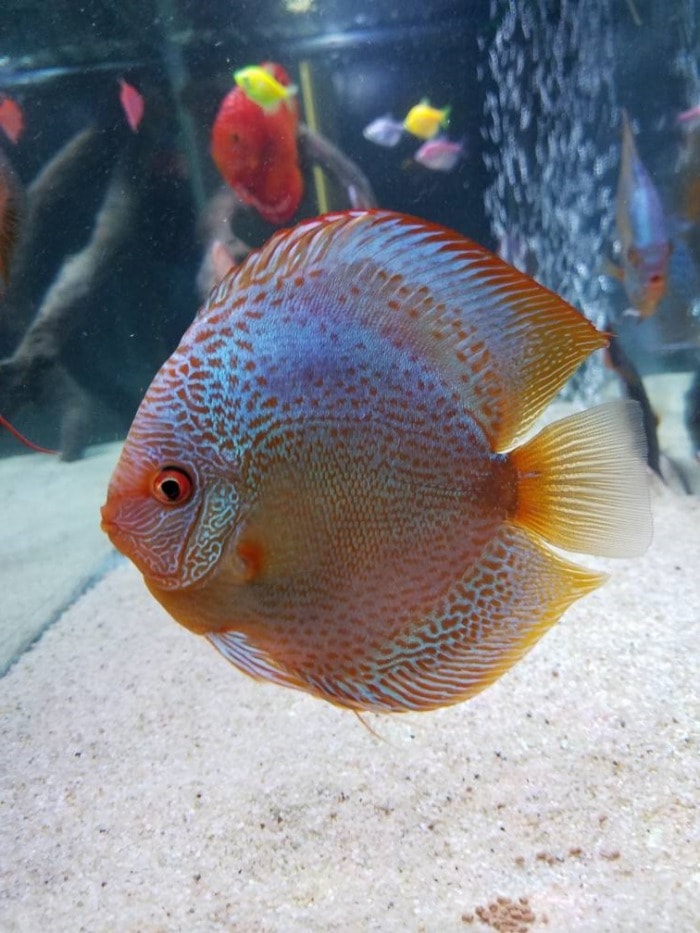
by Bayareareefer18
| Minimum Tank Size: | 75 gallons or larger |
| Maximum Body Size: | 4.8-6 inches (12.3-15.2 cm), but some specimens could grow up to 9 inches (23 cm) |
| Setup: | Freshwater |
| Suitable for Beginners: | No |
The aesthetically pleasing shape of the Discus along with its majestic colors, make it one of the best-looking species of freshwater fish.
The notorious disc shape of this fish from the genus Symphysodon is a result of its round body and comb-shaped fins.
There are numerous varieties of Discus fish when it comes to colors, but one of my favorites is The Rot Turkish Discus.
It boasts a multi-colored body with red and blue color patterns along an orange-white head.
Another favorite of mine that’s also worth mentioning, is the Leopard Spotted Discus.
It has a light blue body covered in mesmerizing red rosettes.
Author’s note: Bear in mind that Discus fish are relatively large species. An adult specimen can sometimes reach 9 inches in size. I recommend housing them in a 75 gallon aquarium as a minimum.
7. Firefish Goby – Nemateleotris magnifica

by Fish7
| Minimum Tank Size: | 20 gallons/pair |
| Maximum Body Size: | 3 inches (7.6 cm) |
| Setup: | Saltwater |
| Suitable for Beginners: | Yes |
This Firefish Goby, assigned to the genus known as Nemateleotris, is easily the cutest looking nano fish in my eyes. Its long, slender body along with an elongated dorsal fin makes it stand out from other nano fish.
Its odd dorsal fin isn’t just for show, either.
It’s actually used as a locking mechanism that allows the firefish goby to lock itself into crevices.
In doing so, it prevents predators from pulling it out.
The color palette of the firefish goby is just as striking as its body shape.
It has a yellow face and a white-colored front body which overflows to red and black as it reaches its rear end.
Author’s note: Even though fire gobies are nano fish, they require an aquarium of at least 20 gallons of water. This is good because there are some interesting fish stocking ideas for a 20-gallon saltwater tank.
6. Palette Surgeonfish – Paracanthurus hepatus

by Vette67
| Minimum Tank Size: | 75 gallons |
| Maximum Body Size: | 9.8-12.2 inches (25 to 31 cm) |
| Setup: | Saltwater |
| Suitable for Beginners: | No |
Also known as the Blue Tang, the palette surgeonfish from the Paracanthurus genus has an electric blue coating, marked by a horizontal black stripe.
The stripe starts from the eyes and runs through the entire body all the way to the tail.
The tail is shaped in the form of a wedge, and nicely contrasts the rest of the body with its lemon color. Given its astonishing look, it’s unsurprising the producers of Finding Nemo chose the palette surgeonfish as a sidekick to Marlin.
Author’s note: Palette Surgeonfish often deal with predators by playing dead. When there’s one nearby, they lie on their side and remain still until he goes away.
5. Banggai Cardinalfish – Sphaeramia nematoptera
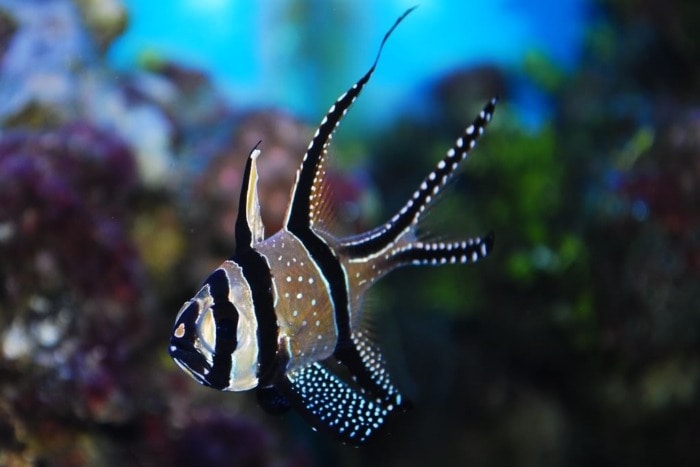
by Trex
| Minimum Tank Size: | 30 gallons (a 15-gallon tank is not out of the question, but only if you’re advanced) |
| Maximum Body Size: | Up to 3 inches (7.6 cm) |
| Setup: | Saltwater |
| Suitable for Beginners: | Yes |
The visual appearance of the Banggai Cardinalfish, a member of the Sphaeramia genus, is characterized by a silver body coat which is mottled with white specks.
However, the standout feature of these fish is their zebra-like vertical stripes.
These markings emphasize their long fins in an elegant way and nicely balance out their otherwise simplistic color palette. Known for their gregariousness, these tropical fish like hanging out with other community fish and should be kept in groups of at least eight.
Author’s note: Despite their easy-going nature, Banggai Cardinalfish are actually micropredators. Any small shrimp or fish species might get eaten by them if kept in the same aquarium.
4. Juvenile Emperor Angelfish – Pomacanthus imperator
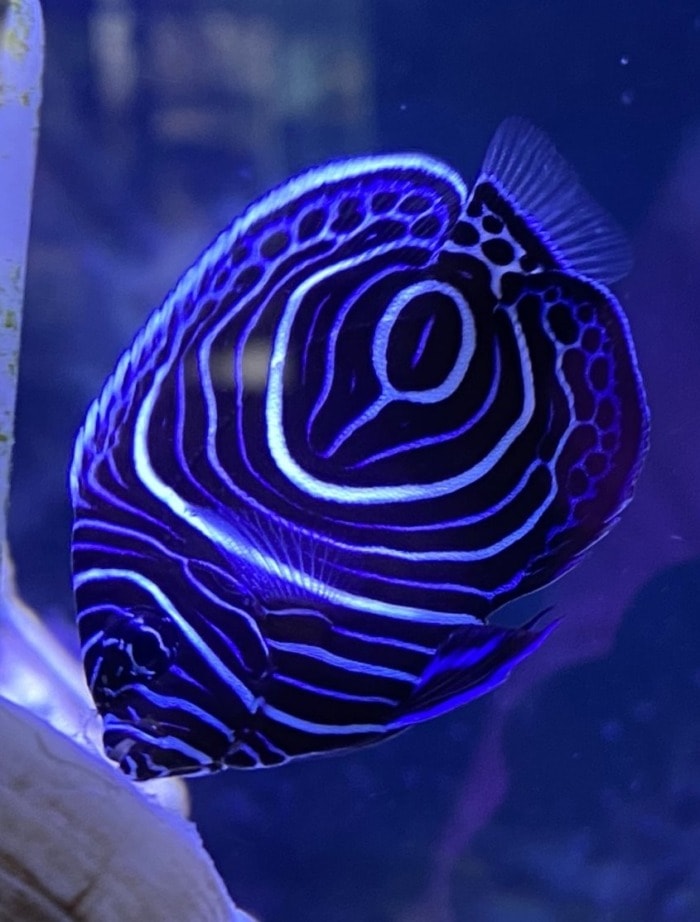
by Wen
| Minimum Tank Size: | 125 gallons |
| Maximum Body Size: | 12 inches (30.5 cm) in captivity |
| Setup: | Saltwater |
| Suitable for Beginners: | No |
The Emperor Angelfish is a proud member of the Pomacanthus genus.
When young, Emperor Angelfish have a mesmerizing color pattern of undulating white and blue stripes.
Sadly, their color scheme changes completely when they reach adulthood.
This transformation may take from four months up to a year, depending on their diet and levels of stress.
It is believed that an Emperor Angelfish doesn’t retain the vibrancy of its colors the same way it does in the wild, once it has transformed.
To avoid this, you should keep your Emperor Angelfish on a varied diet of raw shrimp, Mysis shrimp, and commercially prepared Angelfish formulas as well as Spirulina and other marine algae.
3. Porcupine Puffer – Diodon holocanthus
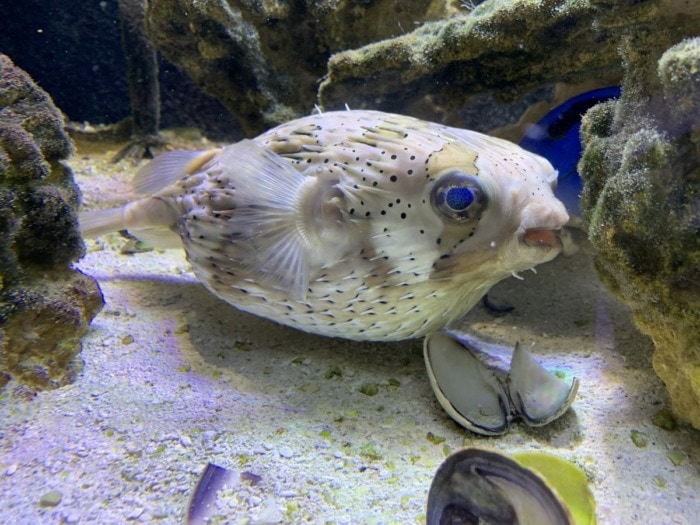
by Justin_Reef
| Minimum Tank Size: | 180 gallons |
| Maximum Body Size: | 20 inches (50.8 cm) |
| Setup: | Saltwater |
| Suitable for Beginners: | No |
This captivating marine fish is a member of the Diodon genus.
I firmly believe that seeing one of these cuties can lighten the mood of anybody.
Even the coldest of hearts, wouldn’t be able to resist the charm of their comical eyes and silly grin.
What’s more, their personality matches their visual appearance.
These oddballs learn to interact with people in surprisingly interesting ways.
For instance, some may swim up to the top of the aquarium and beg for food, once they start recognizing their owner.
One of the downsides of owning a Porcupine Puffer is its size.
Another point of concern is sloppiness.
Puffers are notorious for being messy eaters who produce tons of waste.
Because of this, they require weekly water changes of at least 20% of the tank’s water.
Nonetheless, seeing their silly smile makes all the effort worth your time.
2. Red Lionfish – Pterois volitans
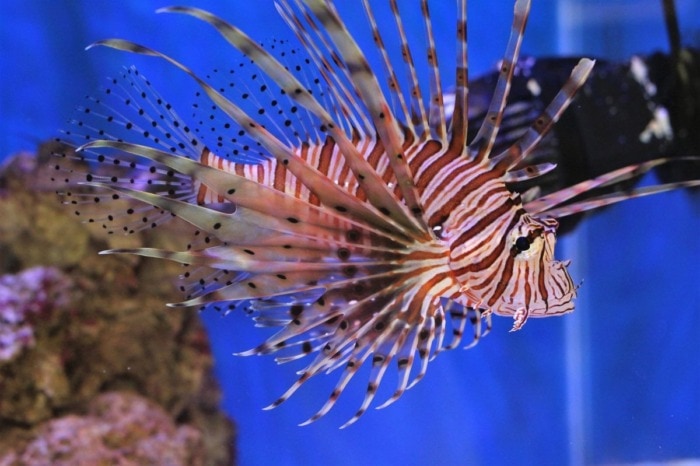
by andrewkw
| Minimum Tank Size: | 120 gallons or bigger |
| Maximum Body Size: | 15 inches |
| Setup: | Saltwater |
| Suitable for Beginners: | No |
Coming from the Pterois genus, the Red Lionfish is without a doubt, one of the most unique-looking fish in the ocean. Their large, fan-like pectoral fins and barbed dorsal spines easily set them apart from any other reef fish.
This along with their alternating red and white vertical stripes gives them an almost alien-like appearance.
However, their stunning appeal comes with a caveat.
The dorsal, anal, and pectoral spines of lionfish are actually venomous.
The sting of a lionfish is close to what you would experience if you get stung by a bee but in a much higher magnitude.
In the case of a lionfish sting, you should carefully remove any broken spines from the wound and then immerse the affected area in hot water for 30 minutes.
If you aren’t deterred by the potential risks, you should keep in mind these fish get relatively large.
An adult lionfish can reach a size of 15 inches and should be kept in a 120-gallon aquarium or bigger.
1. Striped Mandarinfish – Synchiropus splendidus
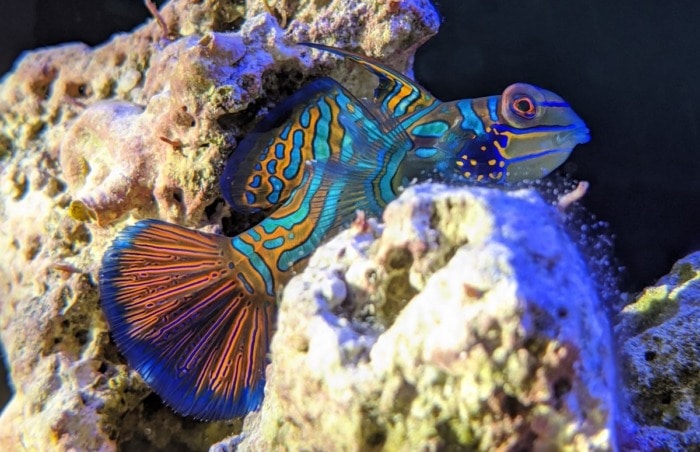
by kyley
| Minimum Tank Size: | 50 gallons or more |
| Maximum Body Size: | 3 inches (7.6 cm) |
| Setup: | Saltwater |
| Suitable for Beginners: | No |
Despite their glamor, none of the previous entries in this list comes anywhere close to the allure of the Striped Mandarinfish, a species within the Synchiropus genus.
Its maze-like combination of colors and unusually shaped body make this exotic fish well worthy of its admiration.
The coloration of Striped Mandarinfish is a mixture of intertwined blue, orange, and green stripes.
This one-of-a-kind color pattern ranks the Striped Mandarinfish among the most colorful fish in the ocean.
The thing I love the most about these fish is their ritual mating dance, however.
At sunset, females gather at the reef in search of a male mate.
Males then try to impress them and intimidate rivals by raising their dorsal fin.
When a female finds a suitable mate, they attach themselves to his pelvic fin and swim to the top of the reef where they release a cloud of eggs and sperm.
Author’s note: Striped Mandarinfish are hard to keep in an aquarium due to their specialized dietary requirements. In order to survive, they must be trained to consume high-quality foods rich in protein.
Which Pet Fish Did You Find Most Beautiful?
Let me know in the comments which fish you liked the most from the ones listed here.
To me personally, saltwater fish look outright exotic and have some very pretty color patterns. I think freshwater fish have their own charm and can be stunning too, but not to the degree their saltwater cousins are.
So there you have it!
These are my top 16 aquarium fish that stand out with their beauty the most.
Feel free to share your picks down in the comment section.


